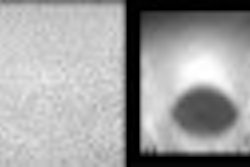Full-field digital mammography continues to impress breast imaging specialists at the University of Colorado in Denver, particularly because it makes repeat exams more convenient.
Dr. John Lewin from the university updated his group’s results with FFDM. At the 2000 RSNA meeting, Lewin reported on the performance of FFDM versus traditional mammography in a screening application. A year later, the group compared usage statistics for FFDM and screen-film in a routine clinical setting.
For this one-year audit, 1,849 FFDM and 5,415 traditional screening and diagnostic exams were performed on one Senographe 2000D digital system and two conventional analog units, a Senographe DMR+ premium system and a Senographe 800T mid-range system (all from GE Medical Systems, Waukesha, WI). Scheduling was based partly on patient preference.
"We have special slots for women who desire to be screened by digital mammography," Lewin explained in a presentation at the 2001 RSNA meeting. "Other women get regular screening or diagnostic slots, but they may be done on either film or digital at the technologist’s discretion.
If a patient does want to be screened on digital, and she arrives and is too large for the digital detector, she is encouraged to have screen-film mammography instead. If she still wants the digital, we go ahead and do the extra views to cover her breast."
A total of 1,630 FFDM screening exams were done, while 3,741 were performed using traditional mammography. The percentage of FFDM exams increased each quarter, from 6.4% to 37.8%.
"The main reason (for the increase) was that the techs realized that they could do a digital exam faster than a film exam, and that it was fine with the radiologists that they use digital, so they started preferentially taking patients who had no preference themselves to the digital," Lewin wrote in an e-mail to AuntMinnie.com.
The cancer detection rate per 1,000 screening exams was 6.1% for FFDM and 5.9% for screen-film. The positive predictive value (PPV) was 5% for FFDM, and 5.7% for screen-film, per 1,000 screening exams. No interval cancers were discovered after negative FFDM exams, while four interval cancers were found after screen-film exams.
The recall rate for screen-film was 11%, versus 11.6% for FFDM. The repeat exposure rate was 2.5% for FFDM and 2.8% for screen-film. As with the number of exams, the repeat exposure rate improved with experience.
"We probably overestimated the digital rate, and that rate has fallen over time," Lewin said. "Early on, there was a problem with technologists not really understanding the digital images and the way they come up in windows, and repeating (exposures) when they didn’t really need repeating." The most common reason for a repeat exposure on FFDM was patient positioning, he added.
Lewin said his group also looked at the rate of unusable films that the technologist didn’t catch, and how that affected recall rates.
"Can the tech actively assess the image on the (FFDM) acquisition station?" Lewin asked. "What I found was that the number of films where the patients had to be called back was the same for film and digital. In both cases, the most common reason was patient motion."
Overall, the sensitivity of FFDM was 100%, versus 85% for screen-film. While previous clinical trials may have reported a lower recall rate for FFDM, Lewin said that was not the case at his institution. One clear advantage FFDM had over screen-film was the vote of the technologists, Lewin said.
"The technologists preferred digital over film, even at our site where they are forced to print films later (for archiving purposes). Talking to the techs, they said it was because it’s so easy to repeat a slightly poorly positioned image on digital," he said. "They seemed to be pickier about positioning, and that accounts for positioning repeats on digital (rather) than film."
By Shalmali PalAuntMinnie.com staff writer
April 5, 2002
Related Reading
With experience, readers prefer full-field digital mammo, November 26, 2001
Is full-field digital mammography worth its weight in gold?, October 22, 2001
Full-field digital mammography compares well to screen-film, November 27, 2000
Mammography market stands at crossroads, September 25, 2001
Copyright © 2002 AuntMinnie.com



















